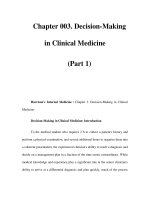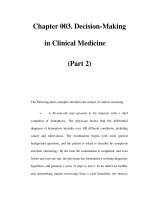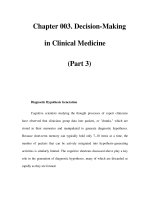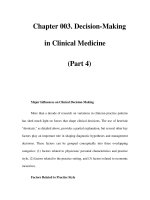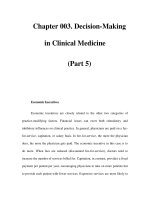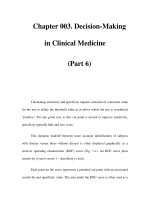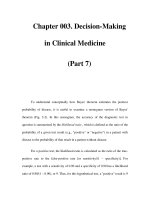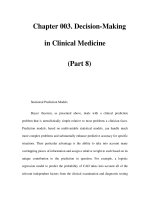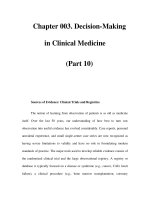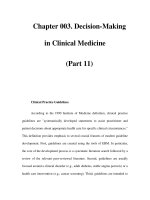Mollison’s Blood Transfusion in Clinical Medicine - part 1 pps
Bạn đang xem bản rút gọn của tài liệu. Xem và tải ngay bản đầy đủ của tài liệu tại đây (613.86 KB, 92 trang )
Mollison’s
Blood Transfusion in
Clinical Medicine
Mollison’s
Blood Transfusion in
Clinical Medicine
11TH EDITION
Harvey G. Klein MD
President of the American Association of Blood Banks;
Chief, Department of Transfusion Medicine
Warren G Magnuson Clinical Center
National Institutes of Health
Bethesda
Maryland, USA;
Adjunct Professor of Medicine and Pathology,
The Johns Hopkins School of Medicine
and
David J. Anstee PhD FRCPath FMedSci
Director, Bristol Institute for Transfusion Science
National Blood Service
Bristol, UK;
Honorary Professor of Transfusion Science, University of Bristol
A revision of the 10th edition written by
P.L. Mollison, C.P. Engelfriet and Marcela Contreras
© 1951, 1956, 1961, 1967, 1972, 1979, 1983, 1987, 1993, 1997
by Blackwell Science Ltd
© 2005 by Blackwell Publishing Ltd
Blackwell Publishing, Inc., 350 Main Street, Malden, Massachusetts 02148-5020, USA
Blackwell Publishing Ltd, 9600 Garsington Road, Oxford OX4 2DQ, UK
Blackwell Publishing Asia Pty Ltd, 550 Swanston Street, Carlton, Victoria 3053, Australia
The right of the Author to be identified as the Author of this Work has been asserted
in accordance with the Copyright, Designs and Patents Act 1988.
All rights reserved. No part of this publication may be reproduced, stored in a retrieval system,
or transmitted, in any form or by any means, electronic, mechanical, photocopying, recording
or otherwise, except as permitted by the UK Copyright, Designs and Patents Act 1988, without
the prior permission of the publisher.
First published 1951 Fifth edition 1972 Ninth edition 1993
Second edition 1956 Reprinted 1974 Reprinted 1994 (twice)
Third edition 1961 Sixth edition 1979 Tenth edition 1997
Reprinted 1963, 1964 Seventh edition 1983 Eleventh edition 2005
Fourth edition 1967 Eighth edition 1987
Reprinted 1967 Reprinted 1988
Library of Congress Cataloging-in-Publication Data
Klein, Harvey G.
Mollison’s blood transfusion in clinical medicine. – 11th ed. /
Harvey Klein and David Anstee.
p. ; cm.
Rev. ed. of: Blood transfusion in clinical medicine / P.L. Mollison,
C.P. Engelfriet, Marcela Contreras. 10th ed. c1997.
Includes bibliographical references and index.
ISBN-13: 978-0-632-06454-0
ISBN-10: 0-632-06454-4
1. Blood Transfusion. 2. Blood groups. I. Mollison, P. L.
(Patrick Loudon) II. Anstee, David J. III. Mollison, P. L.
(Patrick Loudon). Blood transfusion in clinical medicine. IV. Title.
V. Title:
Blood transfusion in clinical medicine.
[DNLM: 1. Blood Transfusion. WB 356 K64m 2005]
RM171.M6 2005
615′.39–dc22
2005012644
A catalogue record for this title is available from the British Library
Set in 9/11.5pt Sabon by Graphicraft Limited, Hong Kong
Printed and bound in the United Kingdom by TJ International Ltd, Padstow, Cornwall
Development Editor: Rebecca Huxley
Commissioning Editor: Maria Khan
Production Controller: Kate Charman
For further information on Blackwell Publishing, visit our website:
The publisher’s policy is to use permanent paper from mills that operate a
sustainable forestry policy, and which has been manufactured from pulp
processed using acid-free and elementary chlorine-free practices. Furthermore,
the publisher ensures that the text paper and cover board used have met
acceptable environmental accreditation standards.
Contents
Foreword, vii
Preface to eleventh edition, ix
Preface to first edition, xi
Abbreviations, xiii
1 Blood donors and the withdrawal of blood, 1
2 Transfusion of blood, blood components and plasma alternatives in oligaemia, 19
3 Immunology of red cells, 48
4 ABO, Lewis and P groups and Ii antigens, 114
5 The Rh blood group system (and LW), 163
6 Other red cell antigens, 209
7 Red cell antibodies against self-antigens, bound antigens and induced
antigens, 253
8 Blood grouping techniques, 299
9 The transfusion of red cells, 352
10 Red cell incompatibility in vivo, 406
11 Haemolytic transfusion reactions, 455
12 Haemolytic disease of the fetus and the newborn, 496
13 Immunology of leucocytes, platelets and plasma components, 546
14 The transfusion of platelets, leucocytes, haematopoietic cells and plasma
components, 611
15 Some unfavourable effects of transfusion, 666
16 Infectious agents transmitted by transfusion, 701
17 Haemapheresis, 774
18 Alternatives to blood transfusion, 810
Appendices, 845
Index, 865
Plate section between pages 528 and 529
v
The first edition of Blood Transfusion in Clinical
Medicine was published in 1951, at a time when the
subject was, if not in its infancy, certainly in its very
early childhood. Transfusions were given for the treat-
ment of acute blood loss or for the relief of chronic
anaemia. Platelet and leucocyte transfusions were not
attempted and plasma fractions were not available.
Only a few red cell antigen systems were recognized
and leucocyte or platelet antigens were unknown. It
was understood that syphilis and malaria could be
transmitted by transfusion, and it had recently been
discovered that hepatitis could also be transmitted
although no test for the virus was available. Evidently,
attempting to summarize knowledge of the whole sub-
ject in 1951 was not a very daunting task.
My own position in the years that followed made it
possible for me to devote a great deal of time to trying
to keep the book up to date in successive editions as
the subject expanded in all directions. However, by the
time that the eighth edition was being planned I recog-
nized that, even with a great deal of help from others,
I could not give an adequate account of leucocyte and
platelet antigens or of diseases transmitted by transfu-
sion. Professors Paul Engelfriet and Marcela Contreras,
who had immense experience of these and many other
aspects of the subject, became joint authors, greatly
strengthening the scientific background of the book.
After the tenth edition was published in 1997, the
three of us decided not to continue, but Blackwell
Publishing felt that as the book was an established text
in the field of transfusion they would like to com-
mission a new edition. I must point out that, although
we are clearly responsible for such parts of the text of
the tenth edition as have been retained, credit for the
revision is due entirely to the new authors, who have
had no help of any kind from us. It is fortunate that
two people so highly qualified as Harvey Klein and
David Anstee have been willing to undertake this task.
Harvey Klein is one of the very ablest practitioners
of transfusion medicine in existence and has a wide
understanding of all the clinical aspects of the subject.
David Anstee’s research has vastly increased know-
ledge of the molecular structure of red cell antigens;
the chapters he has revised – particularly the chapter
on the Rh blood group system – now provide what
must be the best available source of information on this
subject. Both authors have dealt in an authoritative
way with the still rapidly expanding specialty, and the
eleventh edition of the book will be of the greatest value
to all who are interested in the scientific and practical
aspects of blood transfusion in clinical medicine.
Professor P.L. Mollison
2005
vii
Foreword
The huge challenge of revising this seminal work
has been both daunting and immensely rewarding.
Mollison’s textbook is an icon. Blood Transfusion in
Clinical Medicine arose from the concept of the trans-
fusionist as both scientist and expert consultant. For
many years, this text provided the primary, and often
the sole, reference for detailed information and prac-
tical experience in blood transfusion. A generation of
scientists and clinicians sought and found in its pages
those fine points of immunohaematology that helped
them manage their patients and satisfy their intellec-
tual curiosity. The last two decades have witnessed an
explosion of scientific knowledge, the proliferation of
textbooks, handbooks, systematic reviews and specialty
journals, not to mention immediate access to manu-
scripts not yet in print via the Internet. The current
authors determined to distil from this mass of informa-
tion the relevant biology and technology for a timely,
comprehensive and clinically useful textbook – without
altering the spirit and character that has made Mollison’s
textbook a cherished companion.
Mollison’s textbook has recorded the development
of blood transfusion practice and its scientific basis for
more than half a century. The first edition focused
mainly on the recognized blood groups and their clin-
ical implications. Immunohaematology was confined
largely to the red cell. The marvellous complexity of
blood was defined by agglutination, and subsequently
by the mixed lymphocyte reaction, lymphocytotoxicity
and serum protein electrophoresis. Red cell survival, a
tool both for investigating clinical problems and for
exploring fundamental information regarding haemo-
lytic processes and red cell pathology, was estimated
‘with the comparative precision of differential aggluti-
nation’. Whole blood was still transfused by the bottle.
Today, tens of millions of units of blood components
are transfused annually. The immune response is ana-
lysed by a wide array of sophisticated techniques and
the diversity of human blood is routinely examined at
the molecular level. Circulating cells and their survival
still teach us about immunology and cellular biology,
but we can now track the persistence of transfused
lymphocyte subpopulations with molecular assays of
microchimerism. This text endeavours to continue the
tradition of integrated biology, technology and clinical
practice that characterized the original book and all
subsequent editions.
Since the last edition, major changes in practice and
advances in our understanding have occurred in some
aspects of the field, but not in others. The human
genome has been sequenced. Informatics and com-
putational biology have revolutionized the approach
to biodiversity. Advances in DNA-based technology,
from microarrays to recombinant proteins, have had a
major impact on many aspects of blood transfusion
practice. Transfusion medicine now involves mobiliza-
tion and selection of haematopoietic progenitor cells
for transplantation, storage of umbilical cord blood,
and manipulation of mononuclear cells by culture and
gene insertion to offer potential therapies for a wide
range of diseases. This edition has been revised to
reflect this remarkable progress. Enormous advances
in protein structure determination have occurred since
the last edition and these too are reflected in the revised
edition. It is particularly satisfying to record the
three-dimensional structure of the glycosyltransferase
responsible for the ABO blood groups just over a
century after Landsteiner’s discovery made safe blood
ix
Preface to eleventh edition
transfusion a possibility. In contrast, Mollison’s text
has traditionally been used as a source of ‘classic’ studies
and information not available elsewhere, and we have
been careful to retain that information in this edition.
We have not attempted to remake this edition into
an exhaustive textbook. By intent, we have eschewed
separate chapters on medicolegal issues, detailed
methods of blood collection, administrative practices,
quality systems, facilities management and cost– benefit
analysis. Instead, we have integrated elements of these
important topics into discussions of clinical problems.
In summary, we have endeavoured to provide the
reader with a comprehensive and authoritative clinical
text on the broad subject of transfusion medicine.
We anticipate that this volume will be used most
frequently by the physician specialist practising in
transfusion medicine. However, we hope that the
book will have equal appeal to the non-specialist (and
non-physician) and would be particularly gratified if it
finds favour among those doctoral and postdoctoral
students with a burgeoning interest in the past, present
and future of blood transfusion in clinical medicine.
We are indebted to many people for advice, support
and assistance. DJA owes particular thanks to Sherrie
Ayles, Nick Burton, Geoff Daniels, Kirstin Finning,
Gary Mallinson, Tosti Mankelow, Peter Martin, Clare
Milkins, Robin Knight and Steve Parsons. HGK
thanks the many physicians and scientists who pro-
vided critique, helpful comments and invaluable expert
advice, particularly Drs James Aubuchon, Mark
Brecher, George Garratty, Dennis Goldfinger, Brenda
Grossman, David Stroncek, Franco Marincola, Maria
Bettinotti, Paul Holland, Paul Schmidt, Jay Menitove,
Paul Mintz, Gary Moroff, Peter Page, Edward Snyder,
Richard Weiskopf and Charles Bolan, and to Mr Boyd
Conley and Ms Patricia Brooks for technical assis-
tance. HGK is especially grateful to John I. Gallin and
David K. Henderson, who provided him the time and
opportunity to work on this edition, and to Sigrid
Klein, without whose support it would not have been
completed.
We owe a special debt of gratitude to Professors
Patrick Mollison, C. Paul Engelfriet and Marcela
Contreras, upon whose solid foundation this edition
was built, and to Maria Khan of Blackwell Publishing,
who kept the book on track.
Harvey G. Klein
David J. Anstee
2005
PREFACE TO ELEVENTH EDITION
x
xi
Blood was once regarded as a fluid of infinite complex-
ity, the very essence of life. The blood of each person
seemed to carry in it the secrets of individuality. As
recently as 1666 it was natural for Mr Boyle, in writing
to Dr Lower, to speculate in the following terms about
the possible effect of cross-transfusion: ‘. . . as whether
the blood of a mastiff, being frequently transfused into
a bloodhound, or a spaniel, will not prejudice them in
point of scent’.
If each person’s blood were as individual as this,
transfusion would indeed be complex and would
deserve to rank as the most refined branch of medicine.
However, this early view of the subtlety of transfusion
was eclipsed at the beginning of the century by the dis-
covery that the blood of all human beings could be
divided into four groups. It seemed that, provided
blood of the same group was transfused, one person’s
blood was indistinguishable from another’s. Indeed,
it came to be believed that people who belonged to
the common group O could give their blood to anyone
whatsoever. This point of view reached its widest
acceptance in the early 1940s, when hundreds of
thousands of bottles of group O blood were given as a
general panacea for the injuries of war, with remark-
ably satisfactory effects. As a result of this experience,
a generation of medical men has grown up believing
that blood transfusion is one of the simplest forms of
therapy.
And yet, this view of the interchangeability of blood
has to be reconciled with the growing knowledge of its
immense complexity. There are so many possible com-
binations of blood group antigens that the commonest
of them all occurs in only 2% of the English popula-
tion. Indeed, such is the individuality of the blood that,
in Race’s striking phrase, certain combinations ‘may
never have formed the blood of an Englishman’.
The explanation of this apparent paradox – the
potential complexity of transfusion and its actual
simplicity – lies in the fact that many blood group fac-
tors are so weakly antigenic in man that they are not
recognized as foreign by the recipient. However, it
can no longer be maintained that a knowledge of the
ABO system constitutes an adequate equipment for the
transfusionist, for the role of some of the other systems
is by no means negligible. Thus, a book on blood trans-
fusion requires a special account of blood groups, in
which the emphasis laid on any one of the antigens
depends upon the part that it plays in incompatibility.
A good understanding of the effects of transfusion
requires two further accounts: one of the regulation of
blood volume and of the effects of transfusion on the
circulation, and one of the survival of the various ele-
ments of blood after transfusion. The survival of trans-
fused red cells has become a matter of special interest.
Red cells survive for a longer period than any of the
other components of blood, and their survival can be
estimated with comparative precision by the method
of differential agglutination. A study of the survival
of transfused red cells has proved to be of great value
in investigating haemolytic transfusion reactions. In
addition, it has contributed strikingly to fundamental
knowledge in haematology by demonstrating the
diminished survival of pathological red cells and the
existence of extrinsic haemolytic mechanisms in dis-
ease. Transfusions are now not uncommonly given for
the purpose of investigation as well as of therapy.
This book is thus composed mainly of an account
of blood groups from a clinical point of view and of
Preface to first edition
knowledge. Dr J.F. Loutit, Dr I.D.P. Wootton and
Dr L.E. Young are amongst those who have read cer-
tain sections and helped me with their expert advice.
I am even more indebted to Miss Marie Cutbush,
who has given an immense amount of time to helping
to prepare this book for the press and has, on every
page, suggested changes to clarify the meaning of some
sentence. In addition, she has most generously encour-
aged me to quote many joint observations which are
not yet published.
Miss Sylvia Mossom was responsible for typing
the whole book, often from almost illegible manuscript.
I am indebted to her for her skill and patience.
The British Medical Journal, Clinical Science and
The Lancet have been so good as to allow the repro-
duction of certain figures originally published by
them.
Professor P.L. Mollison
1951
xii
descriptions of the effects of transfusion on the circula-
tion and of the survival of transfused red cells; it also
contains chapters designed to fill in the remaining
background of knowledge about the results of trans-
fusion in man. Finally, it contains a rather detailed
account of haemolytic disease of the newborn. It is
addressed to all those who possess an elementary
knowledge of blood transfusion and are interested in
acquiring a fuller understanding of its effects.
In preparing this book I have had the help and advice
of many friends. Dr J.V. Dacie read through almost
all the typescript and made innumerable suggestions
for improvements. Dr A.C. Dornhorst gave me the
most extensive help in writing about the interpreta-
tion of red cell survival cures, and he is responsible
for the simple rules for estimating mean cell life,
which I hope that many besides myself will find useful;
he has also read through the book during its prepara-
tion and given me the benefit of his very wide general
PREFACE TO FIRST EDITION
xiii
aa amino acid
ACD acid citrate dextrose
AChE acetylcholinesterase
ADCC(L) antibody-dependent cell-mediated
cytotoxicity test, using lymphocytes
ADCC(M) antibody-dependent cell-mediated
cytotoxicity test, using monocytes
ADP adenosine diphosphate
Adsol (an) adenine–dextrose solution
AET 2-amino-ethyl-isothiouronium
AHG anti-human globulin
AIDS acquired immune deficiency syndrome
AIHA autoimmune haemolytic anaemia
AITP autoimmune thrombocytopenic
purpura
ALT alanine aminotransferase
AML acute myeloid leukaemia
AMP adenosine monophosphate
AMT aminomethyl-trimethyl (psoralen)
APC antigen-presenting cells
ARC AIDS-related complex
ARDS adult respiratory distress syndrome
ASO allele-specific oligonucleotides
ASP allele-specific primers
ATLS acute trauma life support (system)
ATP adenosine triphosphate
BC buffy coat(s)
BHTC butyryl-n-trihexyl citrate
BP blood pressure
BSA bovine serum albumin
BSS buffered saline solution
C8bp C8 binding protein
CABG coronary artery bypass graft
CAH chronic active hepatitis
CAT column agglutination technique
CAVG coronary artery vein graft
CBPC cord blood progenitor cells
CD cluster differentiation (designation)
CDC Centers for Disease Control and
Prevention
cDNA complementary DNA
CDR Communicable Disease Report
CFU colony-forming units
CGD chronic granulomatous disease
CHAD cold haemagglutinin disease
CL chemiluminescence
CMV cytomegalovirus
COMPRIA competitive radioimmunoassay
CPD citrate phosphate dextrose
CR complement receptor
CREGS crossreactive groups
CSF colony-stimulating factor
CTL cytotoxic T lymphocytes
CVP central venous pressure
DAF decay accelerating factor
DAT direct antiglobulin test
DDAVP desmopressin (1-deamino-8-
D-arginine
vasopressin)
DEAE diethylaminoethyl
DEHP di (2-ethylhexyl) phthalate
DHTR delayed haemolytic transfusion reaction
DIC disseminated intravascular coagulation
DL Donath–Landsteiner
DMSO dimethyl sulphoxide
DNA deoxyribonucleic acid
DPG 2,3-diphosphoglycerate
DR (HLA) D-related
DSTR delayed serological transfusion reaction
Abbreviations
not including abbreviated names of blood group systems or
of any antigens or antibodies
DTT dithiothreitol
EBV Epstein–Barr virus
ECP extracorporeal photopheresis
EDTA ethylene diamine tetra-acetic acid
EIOP endoimmuno-osmopheresis
ELAT enzyme-linked antiglobulin test
ELISA enzyme-linked immunosorbent assay
EPO erythropoietin
ESR erythrocyte sedimentation rate
EVS extravascular space
Fab fragment, antigen-binding
FBS fetal blood sampling
Fc fragment, crystallizable
FCIT flow cytometric immunofluorescence test
FcγRFcγ receptor
FFP fresh-frozen plasma
FUT fucosyl transferase
FVIIIC factor VIII coagulant activity
GAC G antibody capture
G-CSF granulocyte colony-stimulating factor
GIFT granulocyte immunofluorescence
technique
GM-CSF granulocyte–macrophage colony-
stimulating factor
GP glycophorin
CPI glycosyl-phosphatidylinositol
GvHD graft-versus-host disease
HAM HTLV-associated myelopathy
HAV hepatitis A virus
HBLV human B lymphotropic virus
HBV hepatitis B virus
HCC hepatocellular carcinoma
HCV hepatitis C virus
HDN haemolytic disease of the (fetus and)
newborn
HDV hepatitis delta virus
HEMPAS hereditary erythroblastic
multinuclearity with a positive
acidified serum test
HES hydroxyethyl starch
HGV hepatitis G virus
HHV-6 human herpes virus-6
HIV human immunodeficiency virus
HLA human leucocyte antigen
HPA human platelet antigen
HPV B19 human parvovirus
HRF homologous restriction factor
HTC homozygous typing cells
HTLV human lymphotropic virus
HTR haemolytic transfusion reaction
IAT indirect antiglobulin test
IHTR immediate haemolytic transfusion
reaction
IL interleukin
ICSH International Committee for
Standarization in Haematology
i.m. intramuscular
ISBT International Blood Transfusion Society
iu international units
i.v. intravenous
IVIG intravenously administered IgG
LAIR Letterman Army Institute of Research
LAK lymphokine-activated killer (cells)
LAV lymphocyte-associated virus
LCT lymphocytotoxicity test
LDL low-density lipoprotein
LIP low-ionic-strength polybrene
LIS low ionic strength
LISS low-ionic-strength solution
MAC membrane attack complex
MAIEA monoclonal antibody-specific
immobilization of erythrocyte
antigens
MAIGA monoclonal antibody-specific
granulocyte assay
MAIPA monoclonal antibody-specific
immobilization of platelet antigens
MARIA monoclonal anti-Ig radioimmunoassay
MHC major histocompatibility complex
MIRL membrane inhibitor of reactive lysis
MMA monocyte monolayer assay
MPS mononuclear phagocyte system
MPT manual polybrene test
MRC Medical Research Council (UK)
MSBOS maximum surgical blood order
schedule
NANA N-acetyl neuraminic acid
NANB non-A non-B hepatitis
NASBA nucleic acid sequence-based
amplification
NATP neonatal alloimmune
thrombocytopenia (fetus and
newborn)
NIH National Institutes of Health (USA)
NHS National Health Service (UK)
NPBI Nederlands Productie Laboratorium
von Bloedtransfusie Apparatur en
Infusievloeistoffer
ABBREVIATIONS
xiv
ABBREVIATIONS
xv
S-D solvent–detergent (treatment)
SDS-PAGE sodium dodecyl sulphate-
polyacrylamide gel electrophoresis
Se secretor of ABH substances
SGP sialoglycoprotein
sHLA soluble HLA class I antigen
SLE systemic lupus erythematosus
SIRS system inflammatory response
syndrome
SRBC sheep red blood cells
SSO sequence-specific oligonucleotides
SSP sequence-specific primers
STS serological test for syphilis
TAA transfusion-associated AIDS
TA-GvHD transfusion-associated GvHD
t PA tissue plasminogen activator
TOTM tri-(2-ethylhexyl) trimellate
TPE therapeutic plasma exchange
TPH transplacental haemorrhage
TPHA Treponema pallidum
haemagglutination assay
TPO thrombopoietin
TRALI transfusion-related acute lung injury
TSP tropical spastic paraparesis
TTP thrombotic thrombocytopenic purpura
u unit(s)
VDRL Venereal Disease Research Laboratory
serological test for syphilis
VWF von Willebrand factor
WAIHA warm antibody type of AIHA
WB Western blot
ZZAP reagent containing papain and DTT
PBPC peripheral blood progenitor cells
PC progenitor cells or platelet concentrate
PCC prothrombin complex concentrate
PCH paroxysmal cold haemoglobinuria
PCR polymerase chain reaction
PCS plasma collection system
PCWP pulmonary capillary wedge pressure
PEG-IAT polyethylene glycol indirect
antiglobulin test
PKA prekallikrein activator
PLAP placental alkaline phosphatase
PNH paroxysmal nocturnal haemoglobinuria
PPF plasma protein fraction
PPP platelet-poor plasma
PRP platelet-rich plasma
PTH post-transfusion hepatitis
PTP post-transfusion purpura
PUBS percutaneous umbilical blood
sampling
PVP polyvinyl pyrrolidone
RAS red cell additive solution
RFLP restriction fragment length
polymorphism
rgp recombinant glycoprotein
rHuEPO recombinant human erythropoietin
RIA radioimmunoassay
RIBA recombinant immunoblot assay
RIPA radioimmunoprecipitation assay
RNA ribose nucleic acid
SAG-M saline–adenine–glucose–mannitol
SCF stem cell factor
SD standard deviation
Amino acids and their symbols
One-letter code Abbreviation Amino acid One-letter code Abbreviation Amino acid
A Ala Alanine M Met Methionine
C Cys Cysteine N Asn Asparagine
D Asp Aspartic acid P Pro Proline
E Glu Glutamic acid Q Gln Glutamine
F Phe Phenylalanine R Arg Arginine
G Gly Glycine S Ser Serine
H His Histidine T Thr Threonine
I Ile Isoleucine V Val Valine
K Lys Lysine W Trp Tryptophan
L Leu Leucine Y Tyr Tyrosine
procedures, post-donation product quarantine, and
donor tracing and notification when instances of dis-
ease transmission are detected. Each element plays a
role in preventing ‘tainted’ units from entering the
blood inventory. Most transfusion services have devel-
oped evidence-based standards and regulations for
the selection of donors (UKBTS/NIBSC Liaison Group
2001; American Association of Blood Banks 2004)
and quality systems to assure excellence in all phases of
their application (Brecher 2003). Other standards derive
from ‘expert opinion’ and ‘common sense’, and these
policies need to be revisited as scientific information
becomes available.
Blood donors should have the following general
qualifications: they should have reached the age of
consent, most often 18 years, but 17 in some countries
such as the USA and the UK; they should be in good
health, have no history of serious illness, weigh enough
to allow safe donation of a ‘unit’ and not recognize
themselves as being at risk of transmitting infection
(see below). Ideally, donation should be strictly volunt-
ary and without financial incentive (see Chapter 16).
Some blood services impose an arbitrary upper limit on
age, commonly 65 years, or up to age 70 in Denmark
and the UK; however, it seems curiously subjective to
exclude donors on the basis of age alone if they are
otherwise in good health (Schmidt 1991; Simon et al.
1991). The Blood Collection Service should provide
informational literature for prospective blood donors.
After information and counselling about criteria for
donor selection, donors should consent in writing to
the terms of donation, including the use of the donated
blood, the extent of testing, the use of testing results
(including donor notification of positive results) and
Blood donors and
the withdrawal of blood
1
1
Bloodletting was once the treatment for almost all
maladies and, when carried out in moderation, caused
little harm. This chapter includes a discussion of thera-
peutic phlebotomy but is mainly concerned with the
withdrawal of blood or its constituent parts from
healthy donors for transfusion to patients. The chapter
addresses qualification of the donor, statistics regard-
ing collection and use, blood shortages and conditions
that disqualify donors. Complications of blood dona-
tion including iron loss, syncope and needle injuries,
and other less common adverse events are discussed.
Some applications of therapeutic phlebotomy and blood
withdrawal during neonatal exchange transfusion are
outlined.
Blood donation
The blood donor
General qualifications
Qualification of blood donors has become a lengthy
and detailed process, a ‘donor inquisition’ some would
say. Yet blood collection depends on this system of
safeguards to protect the donor from injury and
the recipient from the risks of allogeneic blood (see
Chapters 15 and 16). Sensitive screening tests have
been considered the cornerstone of blood safety for
more than three decades. However, testing represents
only one component of this system. Additional ‘layers
of safety’ include detailed donor education programmes
prior to recruitment, pre-donation informational liter-
ature, stringent donor screening selection and deferral
the future use of any stored specimens. Donors
should be told about the possibility of delayed faint-
ing and about other significant risks of the donation
procedure.
Blood donation has potential medicolegal con-
sequences. If a donor becomes ill shortly after giving
blood, the illness may be attributed to blood donation.
For this reason, among others, it is important to ensure
that donors have no history of medical conditions such
as brittle diabetes, hypertension, poorly controlled
epilepsy and unstable cardiopulmonary disease that
might be associated with an adverse event following
phlebotomy. Pregnancy might be adversely affected by
the donation process and ordinarily excludes a donor.
Donors who become ill within 2 weeks of donation
should be encouraged to inform the transfusion ser-
vice, which may wish to discard the donated blood,
recall any plasma sent for fractionation or follow up
recipients of the blood components as appropriate.
Donors who develop hepatitis or HIV infection within
3–6 months of donation should also inform the Blood
Collection Service.
Donor interview
The donor interview should be conducted by staff
trained and qualified to administer questions and
evaluate responses. The donor interview should be
conducted in a setting sufficiently unhurried and priv-
ate as to permit discussion of confidential information.
With current practices in the USA, approximately 2%
of volunteer donors still disclose risks that would have
led to deferral at the time of donation (Sanchez et al.
2001). Introduction of standardized and validated
questionnaires and the application of interactive
computer-assisted audiovisual health history may
reduce errors and misinterpretations during conduct
of the donor interview (Zuck et al. 2001).
Physical examination
Blood collectors perform a limited physical examina-
tion designed to protect donor and recipient. Screeners
routinely assess the donor’s general appearance and
defer those who do not appear well or are under the
influence of alcohol. A normal range of pulse and
blood pressure is defined, although variances may be
granted for healthy athletes. Body weight and temper-
ature are measured by some collection services. Both
arms are examined for evidence of illicit drug use and
for lesions at the venepuncture site.
Volume of donation
The volume of anticoagulant solutions in collection
bags is calculated to allow for collection of a particular
volume of blood, which, in the UK, is 450 ± 45 ml.
In the USA often 500 ml, but in no case more than
10.5 ml/kg including the additional volume of 20–30 ml
of blood collected into pilot tubes. From donors
weighing 41–50 kg, only 250 ml of blood is collected
into bags in which the volume of anticoagulant solution
has been appropriately reduced. In some countries, the
volume collected routinely is less than 450 ml, for
example 350–400 ml in Turkey, Greece and Italy, and
250 ml in some Asian countries such as Japan, where
donors tend to be smaller.
Record-keeping
It should be possible to trace the origin of every blood
donation and records should be kept for several years,
depending on the guidelines for each country. In many
countries, a system employing unique bar-coded eye-
readable donation numbers is now in use. This system
makes it possible to link each donation to its integral
containers and sample tubes and to the particular
donor session record. Information concerning pre-
vious donations, such as records of blood groups and
microbiology screening tests, antibodies detected, donor
deferrals and adverse reactions are important for
subsequent attendances. Electronic storage of donor
information greatly facilitates accurate identification,
release, distribution and traceability of units of blood
and blood products. An international code, ISBT 128,
is intended to be used by all countries for the accurate
identification of donors and donations (Doughty and
Flanagan 1996). These records must be protected from
accidental destruction, modification or unauthorized
access.
Frequency of donors in the population
Although in many Western countries, some 60% of
the population are healthy adults aged 18–65 years
and thus qualified to be blood donors, the highest
annual frequency of donation in the world corres-
ponds to about 10% of the population eligible to give
CHAPTER 1
2
blood donating once per year, as in Switzerland
(Linden et al. 1988; Hassig 1991). The frequency in
most developing countries is less than 1% (Leikola
1990).
The number of units collected per 1000 US inhab-
itants of usual donor age (18–65) was 88.0 in 2001, up
from 80.8 in 1999. Although this number compares
favourably with the rate of 72.2 per 1000 in 1997, it
pales in comparison with the 100 units per 1000 popu-
lation collected in Switzerland. As treacherous as it
may be to interpret these figures, the numbers suggest
that US collecting facilities are progressively improv-
ing efficiency. Data from the American National
Red Cross indicate that the average volunteer donates
about 1.7 times a year. Losses from outdated red cells
accounted for 5.3% of the supply but, given the fact
that red cells can be transfused only to compatible
recipients, the number of usable units outdated appears
to be extremely small. More than 99% of group O
units and 97% of group A units were transfused
(National Blood Data Resource Center 2001).
Blood utilization and shortages
Despite the constant rise in collections, blood collectors
report frequent shortages and emergency appeals for
blood are disturbingly common. Some 14 million
units of red cells and 12 million units of platelets are
collected annually in the USA. With the current shelf
life, the blood supply more closely resembles a pipeline
than a bank or reservoir. A few days of under collec-
tion can have a devastating effect on supply. Although
most national supermarket chains have developed
efficient bar code-based information systems to mon-
itor perishable inventory on a daily basis, few national
blood services have as accurate an accounting of blood
component location and availability by group and
type. Furthermore, there is little general agreement
about what constitutes a shortage. Measures of post-
poned surgery and transfusion, as well as increased
rates of RhoD-positive transfusions to RhoD-negative
recipients provide some indication of shortage at the
treatment level. In a national survey in the USA in
2001, 138 out of 1086 hospitals (12.6%) reportedly
delayed elective surgery for 1 day or more, and 18.9%
experienced at least 1 day in which transfusion was
postponed because blood needs could not be met
(National Blood Data Resource Center 2002). A separ-
ate government-sponsored study revealed seasonal
fluctuations of blood appeals and cancellations of
surgery for lack of platelet transfusion support
(Nightingale et al. 2003). In the former survey, blood
utilization approached 50 units per 1000 of the popu-
lation, an increase of 10% over the previous survey
2 years earlier and the average age of a transfusion
recipient was 69 years. The USA decennial census
2000 projects that, by the year 2030, the population
of Americans over the age of 65 will increase from
12% to 20%; this figure will be even higher in most
countries in western Europe (Kinsella and Velkoff
2001). Given these projections, developed countries
may expect blood shortages to become a way of life
unless substantial resources are invested in donor
recruitment and retention. In developing countries,
this is already the case.
The shrinking donor pool: the safety vs.
availability conundrum
Donor deferrals and miscollected units have an
increasing role in blood shortages. In a 1-year study at
a regional blood centre, nearly 14% of prospective
donors were ineligible on the day of presentation and
more than 3.8% of donations did not result in the col-
lection of an acceptable quantity of blood (Custer et al.
2004). Short-term deferral for low haemoglobin (Hb)
was the overwhelming reason for the deferral of
female donors in all age groups, representing more
than 50% of all short-term deferrals. In first-time
female donors, low Hb accounted for 53–67% of
deferrals within different age groups, and for repeat
female donors 75–80% of deferrals. In both first-
time and repeat male donors aged 40 years and older,
the most common reason for short-term deferral was
blood pressure or pulse outside allowed limits. For
persons aged 16–24 years, regardless of sex and dona-
tion status, the most common reason for lengthy defer-
ral was tattoo, piercing or other non-intravenous drug
use needle exposure. For 25- to 39-year-old female
donors, needle exposure was also the most common
reason, whereas for male donors, travel to a malarial
area was more common. For all ages over 40, the most
common reason for long-term deferral was travel to a
malarial area.
Measures introduced to increase blood safety may
have the unintended consequence of decreasing blood
availability. Results from demographic studies indicate
that certain donor groups or donor sites present an
BLOOD DONORS AND THE WITHDRAWAL OF BLOOD
3
unacceptable risk of disease transmission. For example,
blood collectors no longer schedule mobile drives at
prisons or institutions for the disabled because of the re-
cognized high prevalence of transfusion-transmissible
viruses. Few would argue the risk–benefit analysis of
these exclusions. More questionable were the tem-
porary exclusions of US soldiers exposed to multiple
tick bites at Fort Chaffee, Arkansas, and the lengthy
deferrals of veterans who served in Iraq and Kuwait
because of the fear that they might harbour Leishmania
donovani, an agent infrequently associated with trans-
fusion risk. Donors who have received human growth
hormone injections have been indefinitely deferred
because of the possible risk of transmitting Creutzfeldt–
Jakob disease (CJD); however, relatives of patients
with ‘sporadic’ CJD are still deferred in the US (except
for preparation of plasma fractions) despite evidence
of their safety. There have now been five case–control
studies of more than 600 CJD cases, two look-back
studies of recipients of CJD products, two autopsy
studies of patients with haemophilia and mortality
surveillance of 4468 CJD deaths over 16 years without
any link to transmission by transfusion (Centers for
Biologic Evaluation and Research, US Food and Drug
Administration 2002). Although the impact of this
deferral on the US blood supply has been negligible,
the recent indefinite deferral of donors who resided
in the UK for a total of 3 months or longer between
1980 and 1996, and the complicated deferral policy
for residents and visitors to the European continent,
designed to reduce a calculated risk of transmission
of the human variant of ‘mad cow disease’ (variant
Creutzfeldt–Jakob disease, vCJD), has had a sub-
stantial impact, a loss of as much as 10% by some
estimates, particularly on apheresis donors (Custer
et al. 2004). Additional donor exclusions appear to be
on the horizon.
Donor medications constitute another significant area
of deferral losses. Certain medications, for example
etretinate (Tegison), isotretinoin (Accutane), acitretin
(Soriatane), dutasteride (Avodart) and finasteride
(Proscar), have been identified as posing potential
risk to transfusion recipients because of their terato-
genic potential at low plasma concentrations. Such
exclusions have little impact on blood safety but each
shrinks the potentially eligible volunteer donor pool.
More troublesome, although not as numerous, are
donor deferrals resulting from false-positive infectious
disease screening tests. This problem has been recog-
nized since the introduction of serological tests for
syphilis. However, during the past 15 years, the intro-
duction of new screening tests and testing technologies
has resulted in numerous deferrals for ‘questionable’
test results and either complex re-entry algorithms
or no approved method to requalify such donors.
Surrogate tests used for screening have proved particu-
larly troublesome (Linden et al. 1988). However, even
specific tests result in inappropriate deferrals. Of
initial disease marker-reactive donations, 44% proved
to be indeterminate or false positive (Custer et al. 2004).
Each year an estimated 14000 donors are deferred
from donating blood for an indefinite period because
of repeatedly reactive enzyme immunoassay (EIA)
screening tests for human immunodeficiency virus
(HIV) and hepatitis C virus (HCV), and several hun-
dred donors are deferred for apparently false-positive
nucleic acid testing (NAT) results (L Katz MD, per-
sonal communication).
Registry of bone marrow donors
Voluntary blood donors are highly suitable to become
bone marrow or peripheral blood stem cell donors for
unrelated recipients, and many transfusion services
now recruit them for this purpose. From its founding
in 1986 until August 2003, the National Marrow
Donor Program in the USA had registered more than
5 million bone marrow and blood stem cell donors, and
Bone Marrow Donors Worldwide in the Netherlands
records more than 8 million donors from 51 registries
in 38 countries. Standards for acceptance of stem cell
donors are based on blood donor eligibility. A uniform
donor history is being developed.
Conditions that may disqualify a donor
Carriage of transmissible diseases
The most important infectious agents transmissible
by transfusion are the hepatitis viruses B and C, HIV,
human T-lymphotropic viruses (HTLVs), bacteria
and the agents causing malaria and Chagas’ disease.
Increasing attention is being paid to the risks of
‘emerging’ agents and newly recognized infectious
risks of transfusion such as West Nile virus, babesiosis
and vCJD. Steps that should be taken to minimize the
risk of infecting recipients with the agents of these and
other diseases involve exclusion based on geographical
CHAPTER 1
4
residence, signs and symptoms of disease, high-risk
activity and demographics associated with risk trans-
mission (American Association of Blood Banks 2003);
see also Chapter 16. Donors who have been exposed
to an infectious disease and are at risk of developing it
should be deferred for at least the length of the incuba-
tion period.
Recent inoculations, vaccinations, etc.
To avoid the possibility of transmitting live viruses (e.g.
those of measles, mumps, rubella, Sabin oral polio
vaccine, yellow fever, smallpox), donors should not
give blood during the 3 weeks following vaccination.
In subjects immunized with killed microbes or with
antigens (cholera, influenza, typhoid, hepatitis A and
B, Salk polio, rabies, anthrax, tick-borne and Japanese
encephalitis) or toxoids (tetanus, diphtheria, pertussis),
the interval is normally only 48 h. These recommenda-
tions apply if the donor is well following vaccination.
Plasma from recently immunized donors may be useful
for the manufacture of specific immunoglobulin pre-
parations. Donors who have received immunoglobulins
after exposure to infectious agents should not give blood
for a period slightly longer than the incubation period
of the disease in question. If hepatitis B immunoglobu-
lin has been given after exposure to the virus, donation
should be deferred for 9 months to 1 year; similarly,
if tetanus immunoglobulin has been given, donation
should be deferred for 4 weeks. When rabies vaccina-
tion follows a bite by a rabid animal, blood donations
should be suspended for 1 year. In developed coun-
tries, tetanus and diphtheria immunoglobulin is derived
from human sources. However, horse serum is still
used in some parts of the world. Donors who have
received an injection of horse serum within the pre-
vious 3 weeks should not donate blood because
traces of horse serum in their blood might harm an
allergic recipient. The administration of normal human
immunoglobulin before travelling to countries where
hepatitis A is endemic is not a cause for deferral.
Group O subjects may develop very potent
haemolytic anti-A following an injection of tetanus
toxoid, typhoid-paratyphoid (TAB), vaccine or pepsin-
digested horse serum, which may contain traces of
hog pepsin. In the past, the use of such subjects as ‘uni-
versal donors’ sometimes led to severe haemolytic
transfusion reactions in group A subjects. Platelet con-
centrates collected by apheresis from subjects with
hyperimmune anti-A should not be used for trans-
fusion to group A or AB patients in view of the large
volume of plasma needed to suspend the platelet
concentrate.
Ear-piercing, electrolysis, tattooing, acupuncture
All of these procedures carry a risk of transmission of
hepatitis or HIV infection when the equipment used is
not disposable or sterilized, and blood donation should
then be deferred for 12 months. In the UK, donors are
accepted if the acupuncture is performed by a regis-
tered medical practitioner or in a hospital. Although
the association between tattooing and exposure to
hepatitis C is generally acknowledged (Haley and
Fischer 2003), less clear is whether a tattoo performed
by licensed and inspected facilities carries more risk
than a trip to the dentist’s surgery.
‘Allergic’ subjects
Subjects who suffer from very severe allergy are unac-
ceptable as donors because their hypersensitivity may
be passively transferred to the recipient for a short
period (see Chapter 15). Subjects with seasonal allergy
(e.g. hay fever) may donate when not in an active
phase of their hypersensitivity. A screening test for
immunoglobulin E (IgE) antibodies would not help to
identify those allergic individuals with an increased
chance of passively transferring their hypersensitivity
(Stern et al. 1995).
Blood transfusions and tissue grafts
Donations should not be accepted for at least 12 months
after the subject has received blood, blood components
or grafts. Increasingly, donors who have received
transfusion in the UK are being deferred indefinitely as
a precaution against transmission of vCJD.
Surgery and dental treatment
When surgery has been carried out without blood
transfusion, donation may be considered when the
subject has fully recovered. Uncomplicated dental
treatments and extractions should not be a cause for
prolonged deferral, as utensils are sterilized and the
risk of bacteraemia persisting for more than 1 h is
negligible (Nouri et al. 1989).
BLOOD DONORS AND THE WITHDRAWAL OF BLOOD
5
Medication
Many subjects taking medication are not suitable as
donors because of their underlying medical condition.
Others are unsuitable as donors because the drugs they
are taking, for example anticoagulants or cytotoxic
agents, may harm the recipients (Mahnovski et al.
1987). Subjects who have taken aspirin within the
previous week are unsuitable when theirs are the only
platelets to be given to a particular recipient. Ingestion
of oral contraceptives or replacement hormones such
as thyroxine is not a disqualification for blood dona-
tion. On the other hand, recipients of human growth
hormone (non-recombinant) should be permanently
deferred from blood donation as should subjects who
have used illicit injected drugs. Deferral for specific
medication use is usually an issue of medical discretion;
the US Armed Services Blood Program has made its
drug deferral list available online (http://military-
blood.dod. mil/library/policies/downloads/medication_
list.doc).
Donors with relatively minor red cell
abnormalities
In some populations, a considerable number of donors
have an inherited red cell abnormality. The three con-
ditions most likely to be encountered are: glucose-6-
phosphate dehydrogenase (G-6-PD) deficiency, sickle
trait (HbAS) and thalassaemia trait.
G-6-PD deficiency. This is the most common red cell
enzyme defect; hundreds of molecular variants have
been catalogued. Although most G-6-PD-deficient
red cells have only slightly subnormal survival and
lose viability on storage with adenine at only a slightly
increased rate (Orlina et al. 1970), some enzyme vari-
ants render the cells unsuitable for transfusion. With
the African variant Gd
A–
present in 10% of African
Americans, a relatively small number of red cells are
severely affected. However, the Mediterranean variant
Gd
Mediterranean
and others render the red cell particu-
larly sensitive to oxidative stress. If the recipient of
one of these units develops an infectious illness or
ingests fava beans or one of any number of drugs (phen-
acetin, sulfonamides, vitamin K, primaquine, etc.), rapid
destruction of the donor’s G-6-PD-deficient cells may
result. Neonatologists avoid using G-6-PD-deficient
blood for exchange transfusion, and subjects who
have evidenced G-6-PD-related haemolysis should be
permanently deferred from donation (Beutler 1994).
Sickle trait (HbAS). Sickle trait red cells survive norm-
ally in healthy subjects, even after storage. However,
in patients subject to various types of hypoxic stress,
these cells survive poorly. HbS polymerizes at low
oxygen tension and the cells are trapped in the spleen
(Krevans 1959). Blood from donors with sickle cell
trait should not be used for infants or for patients with
sickle cell disease who undergo exchange transfusion.
Patients, other than those with sickle Hb, who require
general anaesthesia should have no problems if trans-
fused with HbAS red cells provided that adequate oxy-
genation is maintained. Red cells from subjects with
HbAS are usually unaffected by collection via apheresis,
but those with sickling haemoglobinopathies should not
donate by apheresis and are not suitable for intraoper-
ative salvage. If blood from donors with sickle cell trait is
glycerolized for storage in the frozen state, extra wash
solution must be used during the deglycerolization pro-
cedure (Castro et al. 1981). Sickle trait prevents effective
WBC reduction by filtration (Stroncek et al. 2004).
Thalassaemia trait. This is associated with little or no
reduction in red cell lifespan in most subjects with a
normal Hb concentration and these subjects may be
accepted as donors.
Special conditions in which normally
disqualified donors may donate
In some circumstances, a donor may give blood or
components to be used for a special purpose, even
although the requirements for normal donation are
not met. For example, a donor who is mildly anaemic
or who has recently given birth may give plasma or
platelets by apheresis; the plasma may be needed for
reagent preparation, for example HLA antibodies,
or the platelets may be needed for transfusion to the
newborn infant. Donors at risk for carrying malaria
may give plasma for fractionation. The usual interval
between donations may be waived for important
medical indications. The donor age limitation and a
number of other screening criteria may be modified for
components directed to the recipient of the donor’s
bone marrow. In every case, medical evaluation should
ensure that there is no increased risk to the donor’s
health and that the value of the component outweighs
CHAPTER 1
6
any perceived increase in risk. Under these circum-
stances, informed consent regarding the variance and
documentation of the circumstances is mandatory.
Donation of whole blood
Frequency of donation
The volume lost from a single unit donation is replaced
within 48–72 h. Red cell mass recovers more slowly,
requiring 3–6 weeks. Some collection services bleed
donors no more than two or three times a year; most
do not bleed women who are pregnant or those who
have been pregnant within the previous 6 weeks. The
primary objective of this policy is to protect the donor
from iron deficiency.
There is a wide variation in the recommended min-
imum interval between donations. For example in the
US, in line with World Health Organization (WHO)
recommendations, the interval can be as short as
8 weeks and a maximum of 3 l of blood per year may
be collected (American Association of Blood Banks
2003). Premenopausal women should not donate as
frequently as men (see below). In the Netherlands, men
are bled every 3 months and women every 6 months.
Because few red cells are lost during platelet and
plasmapheresis, these procedures may be performed
more often and at shorter intervals. Standards vary by
country; in the USA plateletpheresis donors may be
drawn every 48 h up to twice per week and 24 times
per year. Commercial plasmapheresis donors are bled
even more frequently; however, physical examination
is more rigorous and laboratory testing more extensive
for these donors. As combinations of components,
such as two-unit red cells, are drawn by apheresis,
volumes and intervals become individualized, but
generally limited by the loss of red cells.
Effect of blood donation on iron balance
Failure to meet the Hb standard is the most common
reason for donor disqualification and iron deficiency,
as a result of frequent donation, most often causes
rejection.
Kinetics of iron loss
More than one-half of the total iron in the body is
in the form of Hb. Adult males have approximately
1000 mg of storage iron, whereas adult females typic-
ally have only 250–500 mg. A twice-per-year blood
donor loses more blood than does the average men-
struating woman, whose annual loss does not norm-
ally exceed 650 ml. In men, iron lost from a 450-ml
donation (242 ± 17 mg) is made up in about 3 months
by enhanced absorption of dietary iron. For women
(217 ± 11 mg), almost 1.5 years would be required
to replace iron lost at donation. Based on these data,
the interval between donations would appear to be no
less than 3 months for men and 6 months or more
for women (Finch 1972). However, even when these
intervals are observed, blood donation seems to cause
iron deficiency. Generally, iron stores are adequate
between the first and second donations. Thereafter, an
increase in iron absorption is necessary to sustain the
increased plasma iron turnover and maintain iron bal-
ance (Garry et al. 1995). In total, 8% of males who
donate four or five times per year and 19% of those
who donate every 8 weeks will become iron deficient.
If these male donors continue to donate, some may still
meet the Hb and/or Hct standard for donation, but
develop red cell indices consistent with iron deficiency.
Some men will qualify to donate even although their
Hb is substantially below their baseline value; others
will be deferred as their Hb level drops below the 12.5-g
requirement (Simon et al. 1981). In a group of healthy
young men who gave blood every 2 months and received
no iron therapy, one-third had no stainable iron in
the marrow after four donations (Lieden 1975). In
another study of donors deferred because of low Hb
concentration, more than 70% had evidence of iron
deficiency (Finch et al. 1977). Similarly, even male
donors who gave blood only twice per year had a
significant fall in mean ferritin levels accompanied by a
lower Hb, red cell count and mean corpuscular Hb
concentration (MCHC) if they had donated more than
10 times (Green 1988). Iron stores are exhausted in
virtually all female donors regardless of the frequency
of blood donations (Conrad 1981).
Oral iron supplementation
The suggestion that repeat blood donors receive iron
supplementation raises a number of scientific, medical
and ethical questions of which the scientific ones are
most easily answered. Oral iron supplementation, if
prescribed in sufficient doses and if taken by the donor,
can increase annual donation frequency without the
BLOOD DONORS AND THE WITHDRAWAL OF BLOOD
7
risk of iron deficiency (Bianco et al. 2002). The sub-
optimal doses found in daily multivitamins will not. In
a study of donors who had given blood either 15 times
or 50 times at the rate of five donations per year and
had received a supplement of 600 mg of Fe
2+
after each
donation, about 75% had no stainable iron in the
marrow (Lieden 1973). These subjects were not anaemic
and had normal serum iron levels. In a further study in
which blood was donated every 2 months, resulting in
an average daily loss of 3.5 mg of iron, iron stores were
not maintained at the initial level, even when the sub-
jects received 100 mg of iron per day (Lieden 1975).
On the other hand, in 12 regular blood donors with
subnormal serum ferritin levels who gave blood every
8 weeks, the ingestion of 5600 mg of iron between
phlebotomies was sufficient to restore serum ferritin
levels to normal and to provide a small store of iron in
the bone marrow (Birgegard et al. 1980). Despite this
finding, some experts believe that frequent bleeding
even with iron supplementation is not justified and
that the maximum annual rate of donation should be
twice for men and once for women (Jacobs 1981).
When the interval between donations is 3 months
or less, iron supplementation in the form of ferrous
iron may be given to try to prevent iron deficiency. In
the past, ferrous sulphate and ferrous gluconate have
been prescribed but some preparations are not well
absorbed, cause gastrointestinal disturbances in many
donors and are potentially fatal if ingested in large
doses by children. For all of these reasons, carbonyl
iron, a small particle preparation of highly purified
metallic iron with high bioavailability and almost no
risk of accidental poisoning in children, seems better
suited for this purpose. A series of studies by Gordeuk
and co-workers (1990) showed that, with a regimen
of 100 mg of carbonyl iron taken daily at bedtime for
56 days, the minimum interval between donations
in the USA is well tolerated and provides enough
absorbable iron to replace whatever is lost at donation
in 85% of donors. A higher dose of carbonyl iron given
for a shorter period of time (600 mg of iron three times
daily for 1 week) caused gastrointestinal side-effects
similar to those seen with ferrous sulphate (Gordeuk
et al. 1987). In a controlled trial designed to prevent
iron deficiency in qualifying female blood donors,
women who received carbonyl iron (100 mg at bed-
time for 56 days) increased their mean number of
donations per year from 2.4 to 3.6 while increasing
their iron stores (Bianco et al. 2002).
Iron supplementation programmes are difficult to
implement and maintain (Skikne 1984). Even ongoing
programmes may have limited effectiveness if the
iron preparation is unpalatable or poorly absorbed
(Monsen et al. 1983). Many blood collectors remain
reluctant to become ‘community clinics’, whereas
others raise concerns about prescribing medication for
normal volunteers in order to extract additional dona-
tions. Finally, some physicians are concerned about
overlooking occult gastrointestinal malignancy as the
stool turns dark with the iron preparation and occult
blood may be lost without the resulting anaemia.
Laboratory monitoring of iron status
Laboratory monitoring can help manage the repeat
blood donor. In normal, well-nourished subjects, serum
ferritin concentration is a good indicator of iron stores
(Worwood 1980), although red cell ferritin may be a
better indicator of body iron status (Cazzola and
Ascari 1986). Red cell ferritin is affected only slightly
by factors other than tissue iron stores (e.g. inflamma-
tion, increased red cell turnover), whereas these factors
may cause a rise in serum ferritin. Several studies
of ferritin estimations in large series have confirmed
that iron stores may be seriously depleted in blood
donors (Finch et al. 1977; Bodemann et al. 1984;
Skikne 1984). For serial blood donors who have com-
plete blood counts performed, a progressive drop in
the red cell indices [mean cell volume (MCV), MCHC]
provides an even easier and less expensive method
of following functional iron status (Leitman et al.
2003).
Screening test to detect anaemia
Subjects should be tested before donation to make sure
that they are not anaemic. A convenient test is to allow
a drop of blood to fall from a height of 1 cm into a
selected solution of copper sulphate and thus to deter-
mine its Hb concentration from the specific gravity. A
more accurate, portable photometric method avoids
some of the environmental hazards of the copper
sulphate technique at a higher cost (James et al. 2003).
In some countries, such as France, the Hb level is
no longer determined before donation. Instead, the
Hb level and the packed cell volume (PCV) of blood
donations are estimated. Donors found to be anaemic
are recalled for investigation.
CHAPTER 1
8
